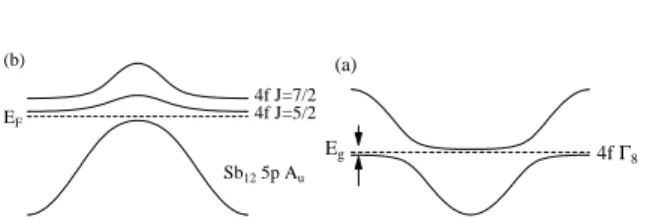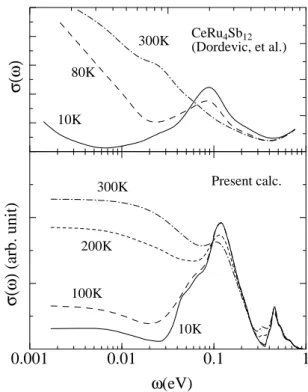Calculation of Optical Conductivity for Kondo insulator YbB 12 and Ce-skutterudites using Realistic Tight-binding Model
T. Saso,
Department of Physics, Saitama University, Saitama-City, Japan
Abstract
In order to understand the electronic structures of the typical Kondo insulator YbB
12and some Ce-based skutterudite compounds with an energy gap or a pseudo-gap, e.g. CeOs
4Sb
12or CeRu
4Sb
12, simple tight-binding band models are constructed. Based on these models, the optical conductivity spectra are calculated to confirm our models and to understand the many-body effect therein. The resultant spectra can explain the shape and the temperature-dependence of the experiments rather well. Especially, the mid-infrared peak due to the f-d transitions and its red-shift at lowering temperature are well reproduced.
Key words: YbB
12, Ce-skutterudites, optical conductivity PACS: 71.27.+a, 71.15.-m, 71.20.-b, 71.20.Eh
Measurement of the optical conductivity is a supe- rior tool to investiate the electronic structures of mate- rials, especially the strongly correlated systems, since the far infra-red spectra can probe the low energy scales of these materials.[1–3] It, however, needs theoretical models and careful calculations to analyze and utilize the experimental results.
We previously found that the electronic structures of the typical Kondo insulator YbB
12and some of the Ce- based skutterudite compounds with an energy gap or a pseudo-gap, e.g. CeOs
4Sb
12or CeRu
4Sb
12can be de- scribed by the simple tight-binding band models.[4,5]
Schematic figures are shown in Fig.1 and the tight- binding band for CeRu
4Sb
12is displayed in Fig.2.[5]
Based on these models, we have calculated the opti- cal conductivity spectra to confirm our models and to understand the many-body effect therein. The latter was taken into account by the self-consistent second- order perturbation theory. In the present paper, we will furnish an improved model and a calculation, and
∗ Corresponding author. Tel: +81-48-858-3369 fax: your num- ber +81-48-858-3369
Email address: saso@phy.saitama-u.ac.jp (T. Saso).
4f J=5/2 4f J=7/2
Sb12 5p Au EF
(b)
4f Γ
8E
g(a)
Fig. 1. Schematic energy-band models for (a)CeRu
4Sb
12and (b)YbB
12.
further comparison with experiments. We also discuss some problems which are still to be solved. Because of the limited space, we focus on CeRu
4Sb
12in the present paper, while the result for YbB
12will be found in the previous paper.[4]
As in the previous calculations, we use the joint-DOS type formula,
σ
indir( ω ) ≡
X
α,α
Z

